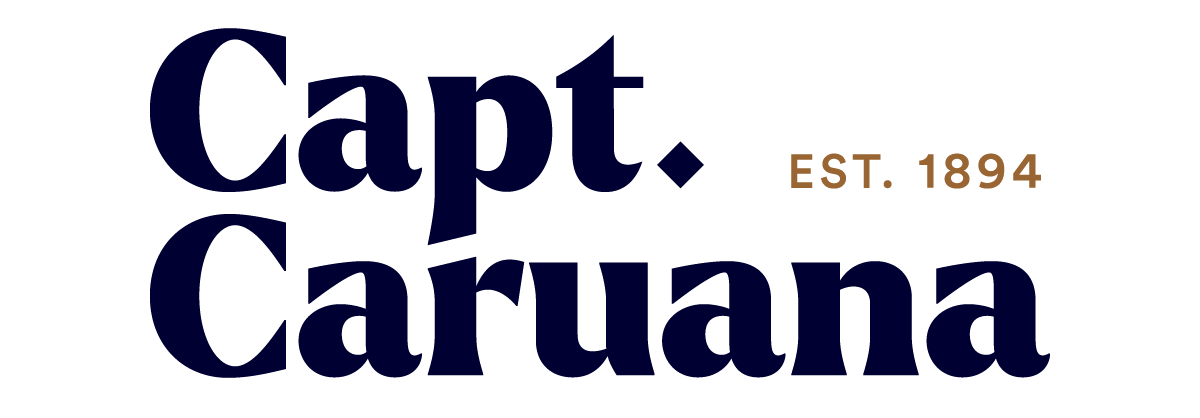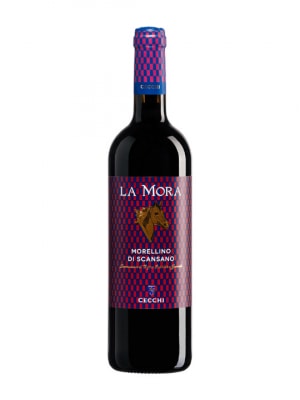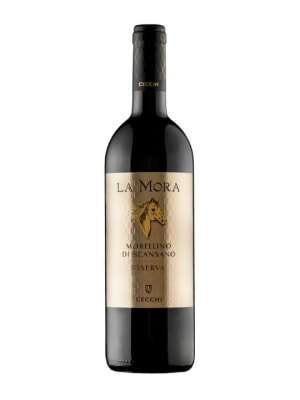Morellino di Scansano DOCG
Morellino di Scansano does not need to age in wood and can be released in March after harvest, meaning that it can be found on the shelf at less than 8 months old, thus is often a fresh and crisp wine. Ruby red colour, a winy aroma with fruity notes, a good freshness and sapidity, combined with softness or sometimes a slight tannic texture.
Morellino di Scansano Riserva can be released on 1 January two years after the harvest, at least one of which it has to age in wood. Intense red colour, which tends to become ruby red with ageing, a fruity aroma (marasca cherries, red fruits and plum), spicy and vanilla notes. When tasted it is dry, full-bodied, from slightly tannic to soft.
Bottling also must be made within the area of production of the grapes, except for the wineries that historically bottled Morellino di Scansano outside the are of production, before the DOCG recognition.
Despite being relatively recent addition to the wine route, the history of Morellino di Scansano DOCG is deeply rooted in the ancient times. Numerous archaeological findings dating back to the Etruscan period, especially in the areas of Scansano and the Albegna valley, prove that the local production of grapevines was already fundamental for the Etruscans. Other discoveries such as terracotta jars containing some vitis vinifera seeds, bronze statuettes and other artefacts confirm the strong relationship with wine at that age. After having conquered the Fortress of Ghiaccioforte, around 280 B.C., the Romans took possession of the territories of Scansano and allow the further development of agriculture. Wine was thus produced for the western provinces of the empire, as evidenced by the discovery of several shipwrecks and kilns used for the production of wine amphorae, which confirm the flourishing trade, both by sea and through the Aurelia and Clodia roads. In fact, the wreck contained a large number of wine amphorae marked with the letters SES, the initials of the powerful Roman Sestii family, traders and landowners in the area of Cosa, present-day Ansedonia. With the decline of the Roman Empire, Scansano, as well as the rest of the Maremma region, inevitably experienced a period of crisis and deterioration due to the abandonment by the population, which led to the hydrogeological instability and swamping of the coastal areas. Although wine production survived around the inhabited centres of earlier Etruscan settlements, the extensive production of the Roman settlements failed. Viticulture remained a residual practice of smallholders and farmers who kept vineyards, often on terraced ground, for wine production destined for family consumption and the local market. After a relative decline in the Middle Ages, during the 19th century the practice of the “Estatatura” (seasonal migration of people), inaugurated by Peter Leopold I of Lorraine in 1737, determined the arrival of the wealthy families in the Scansano area, encouraged by the Grand Duke to invest and enhance the Maremma district. It was a sort of peaceful migration, which lasted from June to October, where the public offices of the province of Grosseto moved to Scansano to escape malaria. According to tradition, Morellino takes its name from the bay horses called ‘morelli’, which were used to tow the carriages of the families and officials when they moved to Scansano. The word ‘morelli’ evokes all the strength and intensity of this type of horses. The name may also come from the morello cherry, a dark red cherry with great tartness and acidity. Morellino di Scansano became a DOCG wine only with the 2007 harvest, even though it was established as a DOC in 1978. The DOCG regulations make some changes to the previous technical specification. The Production area was cemented as the historical one, that is, the whole town of Scansano and part of the towns of Campagnatico, Grosseto, Magliano in Toscana, Manciano, Roccalbegna, Semproniano. Minimum 85% of Sangiovese grapes. Maximum 15% of other grapes from black grape varieties allowed in Tuscany (Canaiolo, Ciliegiolo, Malvasia, Colorino, Alicante, and more recently also Merlot, Cabernet Franc, Cabernet Sauvignon, Syrah, and other international black grape varieties). Production is restricted to 90 quintals per hectare (while the DOC regulation allowed 120 quintals per hectare). Producers historically kept to this limit anyway, despite being allowed more by the DOC regulation. A clear indication of the quality pride in the region. Vinification process must take place only in the production area of the grapes, as provided for by the previous regulation dated back to 1978. Bottling must take place in the production area of the grapes, without prejudice to the right acquired by the firms that have historically bottled Morellino di Scansano outside the aforementioned area before the transition to DOCG. This wine, in the “Vintage” type, shows a ruby red colour, a winy aroma with fruity notes, a good freshness and sapidity, combined with softness or sometimes a slight tannic texture. It can be marketed from the spring after the harvest. The Morellino di Scansano in its Riserva version has an intense red colour, which tends to become ruby red with aging, a fruity aroma (marasca cherries, red fruits and plum), spicy and vanilla notes. These characteristics are due to the long aging, at least two years, one of which in wood. When tasted it is dry, full-bodied, from slightly tannic to soft.
More information at https://www.consorziomorellino.it/


